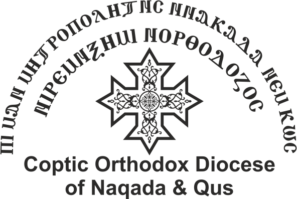Anba Besentaous, the Spirit Bearer, Monastery
Location:
It is located ten km west of Naqada, about two hundred meters southeast of the Great Martyr St. George Monastery, known as “El-Magmaa”. It lies between the monastery of the Cross and of St. Victor monastery. Its church dates to the 18th and 19th centuries and has twelve domes. In the mountain west of the monastery, there are many ruins of monasteries and caves with a lot of Coptic pottery as a mark of the original monastic life in the area of Naqada.
Anba Besentaous, Bishop of Qeft, commanded his disciple to bury him in this place. His disciples built a dome over his grave to be a pilgrimage site for them. Then a church was built later with three altars, the middle of which is in the name of Anba Besentaous.
Fourteen centuries later, on the 8th of July 2018 during the restoration of the middle altar, the relics of Anba Besentaous were discovered lying on a piece of stone with his name carved on it in Coptic about 2 meters deep to the surface. Archaeologists conducting the evacuation of the middle altar noted redness in the sandy brick layer on top of the roman stones used to build the monastery and this turned out to be caused by the purple gown in which the body of Anba Besentaous was wrapped.
The church has a stone of which oil used to ooze out (oil stone) and heal many sick people. St. John, the disciple of Anba Besentaous spoke about it. Although this stone has dried up, the oil markings are still visible.
Water Spring:
Naqada has the privilege of having a water spring (Bir al-Ain), three km northwest of Anba Besentaous monastery, and dates to the seventh century. The water spring is a 150 – 190 cm deep hole supplied with water through channels extending from west to east.
Bir al-Ain holds a special place in the hearts of Christian and non-Christian people in the area, due to the belief among barren women that if they drink its water and go around it seven times, they will bear children. Consequently, many of these women had children.
This water spring was the place where Anba Besentaous dwelled. A few years ago, some researchers tried to explore how the water reaches the spring. They dug deep around the channels and were astonished because they could not find the source of this water. Their excavations are still there pointing to the fingers of God who honors those who glorifies His Holy Name. It is noted that the level the water of the spring clearly rises every year on the commemoration day of the departure of Anba Besentaous (Abib 13).
Clay well:
The clay well is adjacent to the water spring and is very deep. It contains sticky clay that has a green color and a distinctive smell.
The water and the clay of this well have never dried up. The vast majority of Naqada people used the clay of this well to mark the doors of their houses with the sign of the cross.
Due to the importance of this well, both Mawhoub bin Mansour bin Mufrej Al-Iskandarani, eleventh century historian, and Abu Al-Makarim Saad Allah bin Gerges, twelfth/thirteenth century historian wrote about it.









